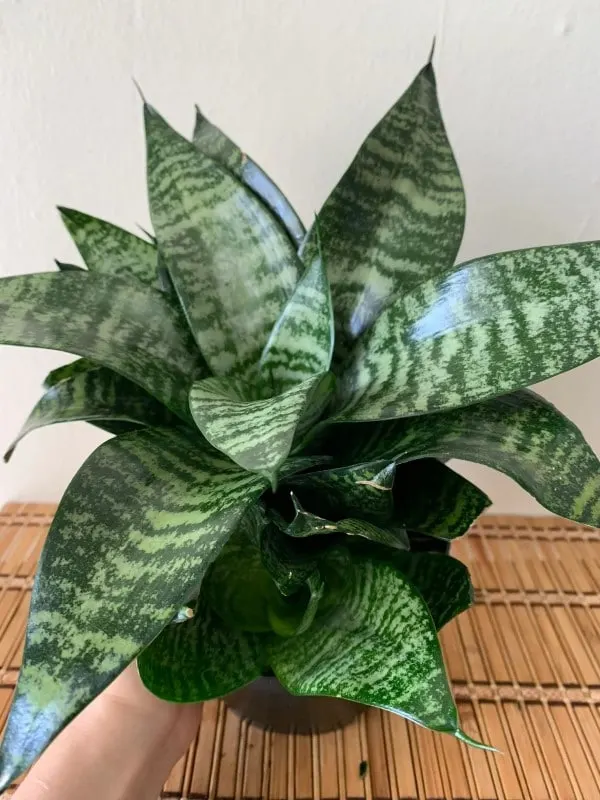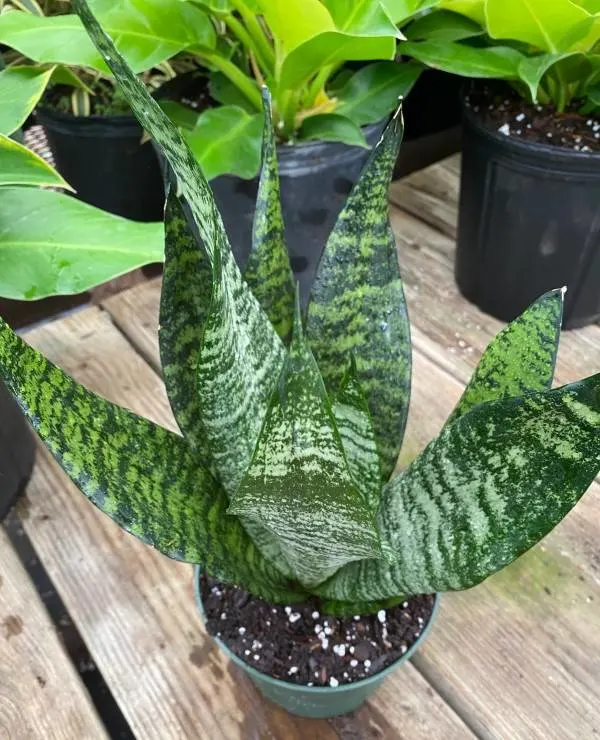The Sansevieria Robusta (AKA Snake plant, or Mother-in-Law’s Tonge) is a clustering, erect succulent plant with attractive structural value. This succulent is a member of the Sansevieria genus of plants, and it is typically found in the tropical regions of western Africa.
This plant is particularly known for its air freshening abilities, which are so powerful that even NASA recommends it as among the top plants for the absorption of pollutants and for improving the quality of air indoors.
The plant is best suited to container cultivation, where its magnificent leaf can be appreciated to its full potential.

The Main Characteristics of the Sansevieria Robusta plant
Flowers & Foliage
It is rare for flowers to blossom from a Sansevieria Robusta plant, but when they do, they appear as long stocks covered with creamy white flowers that have a strong and pleasant fragrance. However, given how rare it is for this plant to bloom flowers, we strongly advise purchasing this plant for its flowers.
One odd observation that many gardeners report is that flowering may be stimulated in the plant whenever it undergoes mild stress for prolonged periods. For example: when your plant becomes root-bound.
Growth
When kept under optimal growing conditions, the Sansevieria Robusta can grow up to a total of around 40 inches (approximately 101 centimeters) in both height and spread.
During the colder seasons, you must not worry if you see your plant not growing at all. This is because during winter seasons, the Sansevieria Robusta goes into a resting period, and the plant’s growth becomes minimal.
Toxicity
One downside to owning a Sansevieria Robusta is that you will have to be careful not to let children or pets approach this plant since the Sansevieria Robusta is toxic if any part of it is ingested. So, if you have small children or pets in your house, make sure you take measures to keep this plant out of their reach.

4 Crucial Caring tips for a healthy Sansevieria Robusta plant
Lighting Needs
The Sansevieria Robusta is pretty well adapted to different levels of lighting conditions. So, you won’t need to do much to meet this plant’s lighting needs. This, of course, does not mean that the Sansevieria Robusta does not have a preference.
This plant is known to grow its best when it is kept under bright but indirect sunlight. For indoor settings, we recommend keeping it near a large window that does not usually receive direct sunlight.
On the other hand, for outdoor plantation, keep your Sansevieria Robusta underneath tall trees with widely spread-out branches or leaves so your plant can enjoy filtered bright sunlight.
Watering Needs
The most important rule to remember regarding this plant’s watering requirements is that no matter what you do, you must never over-water your Sansevieria Robusta. This is because this succulent (like others) is highly susceptible to root rot if it is kept in waterlogged soil for prolonged time periods.
The best way to handle this plant’s watering is by checking (every 7-9 days) the moisture level of the uppermost layer of this plant’s soil using your bare fingers.
If you sense that the soil is moist, you should hold off on watering your Sansevieria Robusta. On the other hand, dry soil should be your green light to going ahead and watering this plant.
Even then, though, you must ensure that you never end up making pools of water when you’re watering this plant; sprinkle just enough water to make your soil moist.
Soil Needs
When it comes to soil, your Sansevieria Robusta will only have two primary demands – both of them are relatively easy to meet. First that your soil must be well-draining, i.e., no excess water should be trapped within it, and second, your soil’s pH hovers around neutral levels.
To improve the drainage properties of your soil, mix some perlite and compost in an equal portion of standard potting soil. This will help the soil drain water better and keep its pH tamed to the optimal levels.
Temperature Needs
The Sansevieria Robusta is relatively pretty well adapted to a wide range of temperature levels. In most cases, you won’t even have to do anything to make sure it is provided with its optimal surrounding temperature levels since the natural temperature of most regions already lies within its optimal range.
More concretely, your plant’s surrounding temperature should ideally remain within ten °C – 30°C. Flexibility with temperature doesn’t mean you can completely neglect this plant’s temperature needs and preferences, though.
If the surrounding temperature is too far above or below the given range, your plant can sustain permanent damage.
Propagation of a Sansevieria Robusta – top 2 methods
The Sansevieria Robusta can be propagated in many ways. The two most popular methods used by gardeners, however, are:
- Propagation by leaf cuttings in soil, and
- Propagation by leaf cuttings in water
Propagation via leaf cuttings in soil
This method is pretty straightforward; all you need to do is:
- Take a healthy leaf cutting from the base of your plant and put it aside for a day or two, so it dries out.
- After this, burry the lower end of your leaf cuttings a couple of centimeters into a nutritious mix of standard potting soil.
- You should ensure that this soil mix drains well- this is crucial for successful propagation.
- Now, all you need to do is wait for a couple of weeks, and your newly grown Sansevieria Robusta will be ready before you even know it.
Propagation via leaf cuttings in water
This method is pretty similar to the soil-based propagation method we laid down above. However, a plus side of using this method is that you will be able to keep track of your plant’s progress as it grows out and establishes its roots. The procedure is as follows:
- Cut off a healthy leaf or two from the base of an existing Sansevieria Robusta plant.
- Allow these cuttings to dry off for two days.
- Now, place this leaf cutting into a jar of fresh water at room temperature.
- Keep your jar in the environmental conditions we outlined above, and after a couple of weeks, you should be able to observe roots developing.
- Keep changing the water of your jar every couple of weeks.
- Once established to a considerable level, you should move your newly propagated Sansevieria Robusta to a more permanent location.
A quick Summary
The Sansevieria Robusta is a lovely tropical plant that isn’t just known for its elegant appearance but also its strikingly powerful air freshening qualities.
Below is a summary of this plant’s crucial caring tips
- Water sparingly
- Keep your plant at room temperature at all times
- Make sure the soil is well-draining and has a neutral pH.
To propagate this plant, use either of the two methods we’ve outlined above.
